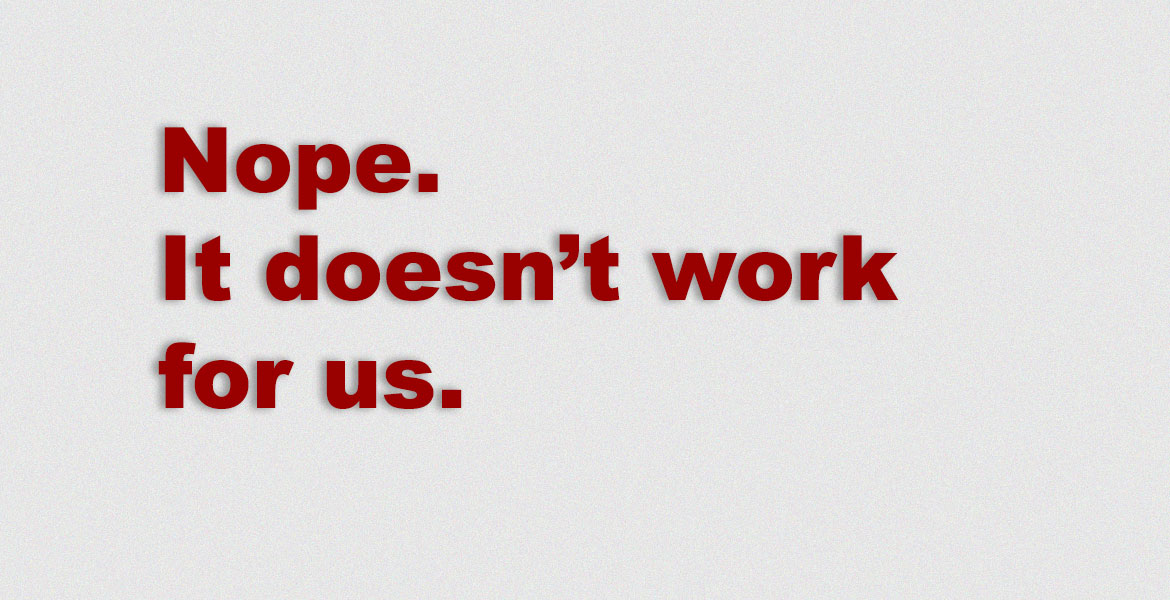The phrases “No, can’t do!” or “thanks, but no thanks!” don’t quite figure in the vocabulary of advertising, marketing and public relations people, do they? And I mean when it is in the context of standing up for what we believe in, or refusing business because it goes against our values, professional instincts, and the interests of our people.
Well that’s the power of money, and the sad-but-true belief that “if i don’t do it their way, someone else will”.
I am perhaps the most flexible of professionals when it comes to listening to the other point of view (more now, as an independent). But I am also a strong believer in saying “no, can’t do” (and have done so, again more as an independent).
The point is however, saying “no” for the right reasons:
- If you’re culturally mismatched or professional work styles differ, it is the obvious thing to say no.
- If the client has a history of “bad relationships” say no, there’s no way you’re going to change that.
- If there is no mutual professional trust and respect, say no. Note, personal trust and respect has nothing to do with the professional side – he/she may make you feel good at an individual level, but professionally you and your teams will suffer.
- If anyone treats your people badly (being rude, unfair, aggressive, etc) stand up for your people. And don’t work with companies who think people are transitory and meant to be used (typical lousy statement: hey, if they can’t handle it, they shouldn’t be in the service industry!)
- If you cannot take on something, due to lack of resources/time/whatever, say no and state the reason honestly (leave a window open). Don’t say yes, because then everyone will suffer.
I am sure everyone has good reasons to say “no”, and “thanks, but no thanks!”
But it’s not just about saying “no”, you have to be sensitive about it, and do it right:
- Lay out the groundrules in the very beginning of a relationship. Outline your expectations and belief systems from the beginning. Understand the other side as well.
- If you see a crisis coming, or know you’re going to say no, give the client a ‘heads up’ as soon as possible, so they can make alternate arrangements. It would be worse, if you leave them in the lurch.
- Say it to the point person in the client’s side, not down the line and expect them to carry the word upwards. Say it one-on-one, with dignity.
- Don’t go public with messy stories or gory details. State differences of values if you have to in press and the public at large. Take your people into confidence, make them feel proud of what you’ve done, but discourage them from tom-tomming the act in public.
- Don’t do it at the drop of a hat, do it after great consideration and talking to your people to know how much is too much. Let your people decide how much they will take, before they risk being broke!
And to the above, I personally work with the target that my biggest client should never exceed 30% of all my business. If it does, I am in deep shit! The point is then to build other businesses, to ensure I’m never being used, or live in the fear of having all my eggs in one basket!
And that, is the greatest support you will have, if you ever want to say “no” …yes??

I also find it hard to say no sometimes. Especially since the people asking for help or certain things are usually business type friends with whom I talk to on marketing forums.
Sometimes you know the partnership isn’t going to benefit your business but you feel guilty by saying no.
Yep, but sometimes you need to take on jobs / projects purely for, as they say, ‘to maintain a relationship’. Many of these are mundane, boring projects which dont add to your bottomline but it’s difficult to say no to them. And eventually, mant times, it’s these these small jobs that work as a long term investment.
For me, ‘ saying no’ works if the client in question is new. With old clients, it does tend to become difficult.
My 2 paisa.
a
p.s I like the point where you say that your biggest client should not exceed 30% of your business. Makes sense. But it tends to become a Catch 22 situation. 30% means that we need to have ‘more’ clients but having ‘more’ clients kills our competitive edge of giving everyone our undivided attention.